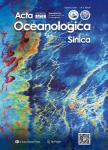Stable carbon and oxygen isotopes of four planktonic foraminiferal species from core-top sediments of the Indonesian throughflow region and their significance
Stable carbon and oxygen isotopes of four planktonic foraminiferal species from core-top sediments of the Indonesian throughflow region and their significance作者机构:State Key Laboratory of Continental DynamicsNorthwest UniversityXi'an 710069China Institute of Cenozoic Geology and EnvironmentDepartment of GeologyNorthwest UniversityXi'an 710069China Marine Geology InstituteBandung 40174Indonesia
出 版 物:《Acta Oceanologica Sinica》 (海洋学报(英文版))
年 卷 期:2016年第35卷第10期
页 面:63-75页
核心收录:
学科分类:0710[理学-生物学] 070704[理学-海洋地质] 0709[理学-地质学] 0908[农学-水产] 07[理学] 0707[理学-海洋科学] 0713[理学-生态学]
基 金:The National Natural Science Foundation of China under contract No.41176044 Shaanxi Provincial Technology Foundation for Selected Overseas Chinese Scholar under contract Shaan RensheNo.1190
主 题:planktonic foraminiferal δ^18O and δ^13C calcification depth freshwater input Java-Sumatra upwelling Indonesian throughflow region
摘 要:Horizontal and vertical distributions of δ^18 and δ^13 were investigated in shells of four planktonic foraminiferal species, Globigerinoides ruber, Globigerinoides sacculifer, Pulleniatina obliquiloculata and Neogloboquedrina dutertrei, from a total of 62 core-top sediment samples from the Indonesian throughflow region. Results were compared to modern hydrologic conditions in order to explore potential of proxies in reconstructing fluvial discharge and upper ocean water column characteristics in this region. Our results show that, in the Makassar Strait, both of depleted δ^18 and δ^13 of these four species were linked to freshwater input. In the Bali Sea,however, depleted δ^18 and δ^13 for these species may be due to different reasons. Depleted δ^18 was a result of freshwater input and as well influenced by along-shore currents while depleted δ^13 was more likely due to the Java-Sumatra upwelling. Comparison of shell δ^18 records and hydrographic data of World Ocean Atlas 2005 suggests that G. ruber and G. sacculifer calcify within the mixed-layer, respectively at 0–50 m and 20–75 m water depth, and P. obliquiloculata and N. dutertrei within the upper thermocline, both at 75–125 m water depth. *** calcifies at slightly deeper water depth than P. obliquiloculata does. In general, δ^13 values of both *** and G. sacculifer are larger than those of P. obliquiloculata and N. dutertrei at all sites, possibly related to depth habitats of these species and vertical distribution of nutrients in the Indonesian throughflow region.



